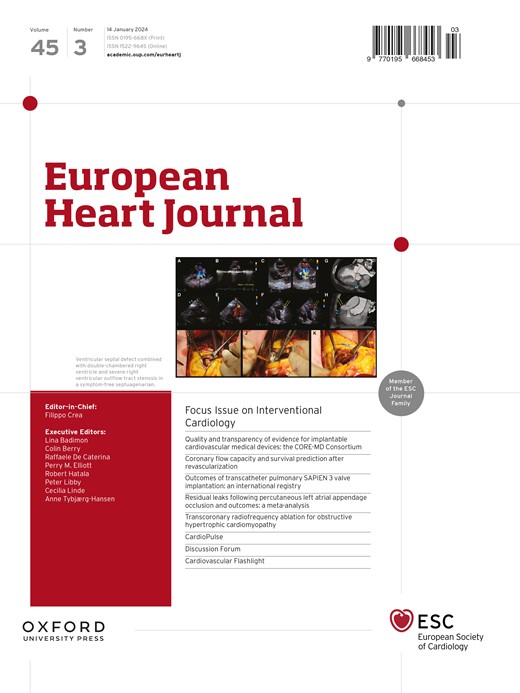子痫与心血管疾病的早期再入院。
IF 37.6
1区 医学
Q1 CARDIAC & CARDIOVASCULAR SYSTEMS
引用次数: 0
摘要
背景和目的子痫前期会增加长期心血管疾病(CVD)的风险。然而,对子痫患者的心血管疾病风险知之甚少,尤其是在产后。本研究的目的是确定子痫患者在分娩后一年内因心血管疾病再入院的风险是否增加。方法使用2010年至2018年全国再入院数据库,确定子痫患者分娩后一年内因心血管疾病事件再入院的情况。确定心血管疾病再入院的患病率(每10万次分娩),并根据混杂因素校正风险比(HR)和95%可信区间(CI)确定子痫和心血管疾病再住院之间的关联。定量偏倚分析解决了子痫错误分类和未测量的混杂偏倚。结果在2700多万例分娩住院患者中,有20478例(每10万人中有74.7例)合并子痫。子痫和血压正常患者的心血管疾病再入院率分别为每10万例分娩住院854例和147例(率差为707,95% CI为473-941;Hr 6.9, 95% ci 4.5-10.4)。特定心脏病类型的hr较高(调整后的hr范围为4.8 - 15.5)。子痫与卒中再入院的高危险性相关(调整后HR 12.6, 95% CI 6.9-22.8)。结论:与血压正常者相比,子痫与CVD并发症的风险增加相关,甚至早在分娩后的第一个月。这些数据强调了对伴有子痫的妊娠患者的心血管疾病并发症进行有针对性的短期随访的必要性。本文章由计算机程序翻译,如有差异,请以英文原文为准。
Eclampsia and early readmission for cardiovascular disease.
BACKGROUND AND AIMS
Pre-eclampsia confers increased risks of long-term cardiovascular disease (CVD). However, little is known about CVD risk among patients diagnosed with eclampsia, especially in the post-partum period. The aim of this study was to determine whether patients with eclampsia are at increased risk for readmission for CVD within the first year after delivery.
METHODS
Using the Nationwide Readmissions Database from 2010 to 2018, readmissions for CVD events were identified during the calendar year after delivery in patients with eclampsia. Prevalence rates of CVD readmission (per 100 000 deliveries) were determined, and associations between eclampsia and CVD rehospitalization were based on a confounder adjusted hazard ratio (HR) with a 95% confidence interval (CI). A quantitative bias analysis addressed eclampsia misclassification and unmeasured confounding biases.
RESULTS
Of over 27 million delivery hospitalizations, 20 478 (74.7 per 100 000) were complicated by eclampsia. CVD readmission rates among the eclampsia and normotensive patients were 854 and 147 per 100 000 delivery hospitalizations, respectively (rate difference 707, 95% CI 473-941; HR 6.9, 95% CI 4.5-10.4). HRs were high for specific heart disease types (range of adjusted HRs 4.8 to 15.5). Eclampsia was associated with a substantially high risk for stroke readmissions (adjusted HR 12.6, 95% CI 6.9-22.8).
CONCLUSIONS
Eclampsia is associated with an increased risk for CVD complications compared with normotensive conditions, even as early as the first month following delivery. These data highlight the need for targeted short-term follow-up for CVD complications among patients whose pregnancies are complicated by eclampsia.
求助全文
通过发布文献求助,成功后即可免费获取论文全文。
去求助
来源期刊

European Heart Journal
医学-心血管系统
CiteScore
39.30
自引率
6.90%
发文量
3942
审稿时长
1 months
期刊介绍:
The European Heart Journal is a renowned international journal that focuses on cardiovascular medicine. It is published weekly and is the official journal of the European Society of Cardiology. This peer-reviewed journal is committed to publishing high-quality clinical and scientific material pertaining to all aspects of cardiovascular medicine. It covers a diverse range of topics including research findings, technical evaluations, and reviews. Moreover, the journal serves as a platform for the exchange of information and discussions on various aspects of cardiovascular medicine, including educational matters.
In addition to original papers on cardiovascular medicine and surgery, the European Heart Journal also presents reviews, clinical perspectives, ESC Guidelines, and editorial articles that highlight recent advancements in cardiology. Additionally, the journal actively encourages readers to share their thoughts and opinions through correspondence.
 求助内容:
求助内容: 应助结果提醒方式:
应助结果提醒方式:


